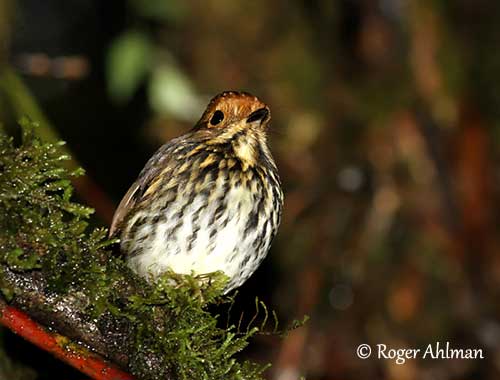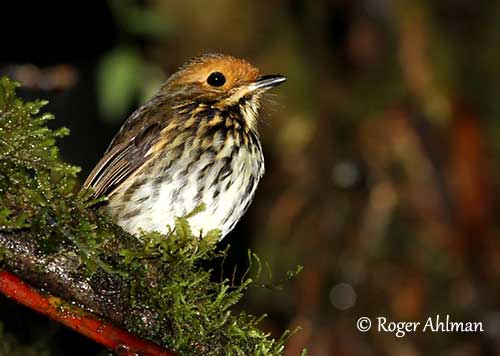
Fr: Grallaire à front ocre
Ang: Ochre-fronted Antpitta
All: Ockerstirn-Ameisenpitta
Esp: Ponchito Frentiocre
Esp Pérou: Tororoi de Frente Ocrácea
Ita: Pitta formichiera fronteocra
Nd: Okerkapdwergmierpitta
Sd: ockrapannad myrpitta
Photographer:
Roger Ahlman
Pbase Galleries Peru and Ecuador & My bird pictures on IBC
Text by Nicole Bouglouan
Sources :
HANDBOOK OF THE BIRDS OF THE WORLD Vol 8 By Josep del Hoyo-Andrew Elliott-David Christie - Lynx Edicions - ISBN: 8487334504
BIRDS OF SOUTH AMERICA – Passerines - by Robert S. Ridgely and Guy Tudor – HELM Field Guides – ISBN: 9781408113424
BIRDS OF PERU by Thomas S. Schulenberg, Douglas F. Stotz, Daniel F. Lane, John P. O’Neill, Theodore A. Parker III – Princeton University Press 2007– ISBN: 978-0-691-13023-1
Birds New to Science: Fifty Years of Avian Discoveries Par David Brewer – Editeur : Bloomsbury Publishing, 2018 – ISBN: 1472945891, 9781472945891 - 416 pages
Neotropical Birds – Cornell Lab of Ornithology
Antpittas and worm-feeders: a match made by evolution?
Wikipedia, la enciclopedia libre
Home page
Page Passeriforme Order
Ochre-fronted Antpitta
Grallaricula ochraceifrons
Passeriformes Order – Grallariidae Family
INTRODUCTION:
The Ochre-fronted Antpitta was discovered recently in 1976 in E Andes of Peru. Two years later, in 1978, two specimens were collected in Dpto. Amazonas and several more specimens were observed in 2002 in Dpto. San Martín.
This species is rare and local. It occurs in the dense undergrowth of montane forest of the Andes and at high elevation.
The Ochre-fronted Antpitta is threatened by habitat loss through clearance of forest for agriculture expansion. It is currently classified as Endangered.

DESCRIPTION OF THE BIRD:
Biometrics:
Length: 10-11 cm
Weight: M: 22-24 g
The Ochre-fronted Antpitta is a plump, long-legged and short-tailed bird. The adult male has distinctive ochraceous forecrown and sides of face, including lores and broad eyering. The hindcrown is mostly olive-brown, like the upperparts.
On the underparts, chin and throat are white with conspicuous black malar stripe. The breast is white with broad black streaks. Body sides and flanks are washed buff, with olive-brown streaks on flanks.
The bill is black, with pink base to lower mandible. There are fairly long rictal bristles around the bill. The eyes are dark brown. Legs and feet are greyish to pinkish-grey.
The female resembles male, but she lacks the ochraceous colour on the head. However, she has brown crown with a faint ochraceous wash and broad creamy-white eyering. The upperparts are darker brown than in male.
The juvenile is not described, but the young birds have usually very fluffy plumage.
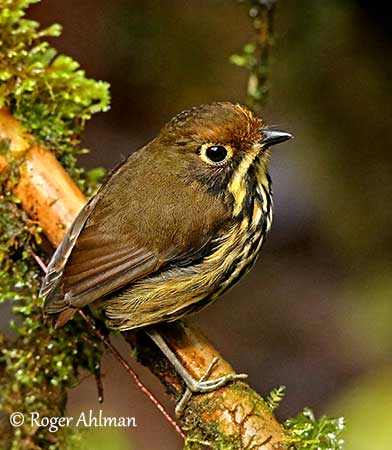
RANGE:
The Ochre-fronted Antpitta is endemic to Peru and can be found in E of the Andes in S Amazonas (Cordillera de Colán) and San Martín (Abra Patricia) south of Río Marañón.
HABITAT:
The Ochre-fronted Antpitta frequents the wet, epiphytic cloud forest, both stunted and tall, and can be seen in the dense undergrowth. This species occurs between 1,800 and 2,500 metres of elevation.
CALLS AND SONGS: SOUNDS BY XENO-CANTO
The Ochre-fronted Antpitta utters a descending, whistling single note “wheeu” or “whiew”. We can also hear a series of four notes, the last strongest, longest and rising “few-few-few-wheea”. The song is usually given from perch.
The female sings more loudly than the male. She responds to playback by aggressive chatter.
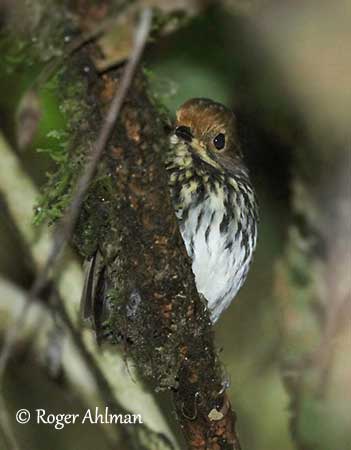
BEHAVIOUR IN THE WILD:
The Ochre-fronted Antpitta is mostly arboreal like other members of this genus. It clings sideways on trunks and lianas.
The long rictal bristles allow the bird to find prey in the thick vegetation of the wet forest. It gleans insects from mossy trunks while hovering, but it also clings to the moss in an awkward sideways posture.
It may occasionally drops to the ground for brief moments, picking prey and making a few jumps and abrupt halts while bobbing and flicking wings and tail in typical antpitta fashion.
From some observations, antpittas also forage in leaf litter disturbed by human workers during construction of trails. This behaviour is also suspected while following large mammals.
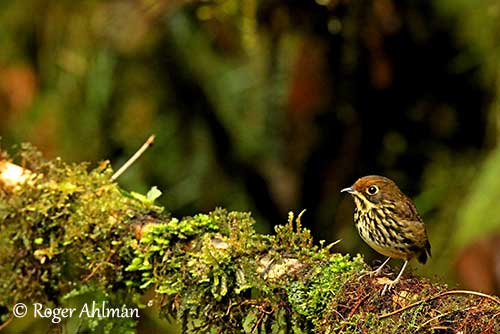
The breeding habits are poorly known. Between bouts of songs, these birds rock the body from side to side without moving the head. Territorial disputes probably occur accompanied by vocalisations.
The Ochre-fronted Antpitta is presumably sedentary.
Being an arboreal species, it often hovers with agility while foraging.
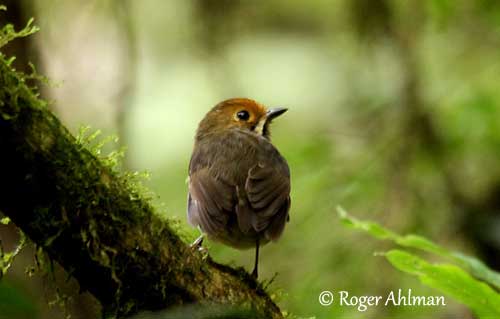
REPRODUCTION OF THIS SPECIES:
Some nests of other species of genus Grallaricula have been described. The nest is often cup-shaped or it is a small shallow platform, both made with twigs and leaves held together with spider webs. They are placed about 1-2 metres above the ground.
The eggs are described as fairly rounded, usually pale greenish, white or pale brown with brown markings at the large end.
No more information.
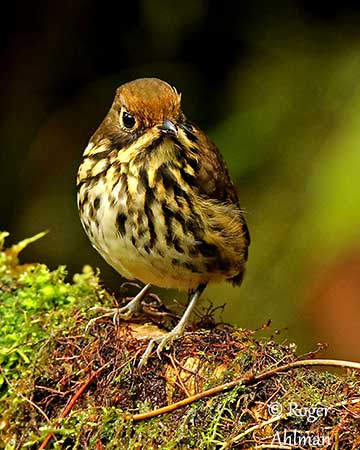
PROTECTION / THREATS / STATUS:
The Ochre-fronted Antpitta has restricted range at high elevation in the Andes of Peru.
The species is heavily threatened by loss of suitable habitat, with clearance for timber and agriculture expansion. Construction of roads in Abra Patricia and population increase make the range under pressure.
The population is roughly estimated to number 250/999 individuals, rounded to 150/700 mature individuals.
The Ochre-fronted Antpitta is currently classified as Endangered.
